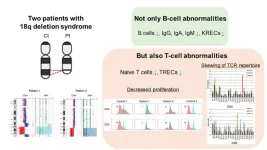(Press-News.org) An increased amount of thick sea ice flowing south from the Arctic Ocean shortened the ice-free shipping season in several parts of the Northwest Passage between 2007 and 2021, according to an analysis in Communications Earth & Environment. The authors suggest this could mean the Northwest Passage is unlikely to become a viable alternative to traditional shipping routes, despite previous hopes that it may become viable due to global warming.
The Northwest Passage (NWP) is a commercial shipping route connecting the Atlantic and Pacific Oceans that runs through the Arctic Circle north of North America. Through the Canadian Arctic Archipelago (CAA), it splits into a southern route and a shorter, preferred northern route. The length of the shipping season — the period during which the route is navigable for certain ships — for the entire NWP has been changing due to global warming.
Alison Cook and colleagues used sea ice charts from the Canadian Ice Service to calculate the number of weeks per year that each 10-kilometre section of the routes through the CAA was navigable by a PC 7 class ship (capable of safely travelling through ice up to 70cm thick) between 2007 and 2021. The authors found that the shipping season during this period had significantly shortened in three sections of the northern route — the eastern edge of the Beaufort Sea (a 14-week decrease), and the M’Clure Strait and Viscount Melville Sound (both 5-week decreases). They also found that the M’Clure Strait (as well as the Larsen, Peel, and Viscount Melville Sounds) acted as choke points in the NWP as they experienced between 10 and 25 fewer navigable weeks than other sections.
The authors say that both the choke points and the decreased shipping season length in some areas are the result of an increase in older, thicker ice flowing south from the Arctic Ocean, due to increased melting under climate change of the oldest Arctic sea ice (in the Last Ice Area). This type of ice poses a greater risk to ships than the younger, thinner ice that was previously most common in the CAA. The authors note that their findings could also be problematic for coastal communities in the CAA, as they rely on shipping for food and goods.
***
Springer Nature is committed to boosting the visibility of the UN Sustainable Development Goals and relevant information and evidence published in our journals and books. The research described in this press release pertains to SDG 11 (Sustainable Cities and Communities) and SDG 13 (Climate Action). More information can be found here.
END
Climate change: Thick sea ice flowing from Arctic Ocean shortening shipping season in Northwest Passage
2024-07-11
ELSE PRESS RELEASES FROM THIS DATE:
State gun laws have mixed impact on suicide and homicide rates
2024-07-11
DURHAM, N.C. – Certain state gun laws are associated with decreased suicide rates for children under age 18, but the laws have little influence on homicide rates, according to a study from Duke Health researchers examining the relationship between gun laws and child deaths.
Since 2020, firearms rank as the leading cause of death among U.S. children ages 1-18, raising the need for research to help guide prevention efforts.
“Our analysis of suicide and homicide mortality data from ...
Treatment approaches for opioid use disorder offered in us substance use treatment facilities
2024-07-11
About The Study: Substance use treatment facilities reported significant gaps in provision of effective treatments for opioid use disorder (OUD). More than one-third of facilities did not offer medications for OUD (MOUD) and less than half offered multiple MOUD types, limiting MOUD treatment options for patients and clinicians.
Corresponding Author: To contact the corresponding author, Tae Woo Park, M.D., M.Sc., email parkt4@upmc.edu.
To access the embargoed study: Visit our For The Media website at this link https://media.jamanetwork.com/
(doi:10.1001/jama.2024.11913)
Editor’s ...
Secondhand nicotine absorption from E-cigarette vapor vs tobacco smoke in children
2024-07-11
About The Study: In this cross-sectional study of U.S. children, nicotine absorption was much lower in children who were exposed to secondhand vapor versus secondhand smoke, but higher than in those exposed to neither. These findings suggest that switching from smoking to vaping indoors may substantially reduce, but not eliminate, children’s secondhand exposure to nicotine and other noxious substances.
Corresponding Author: To contact the corresponding author, Harry Tattan-Birch, Ph.D., email h.tattan-birch@ucl.ac.uk.
To ...
Long-term outcomes of self-fit vs audiologist-fit hearing aids
2024-07-11
About The Study: This comparative effectiveness research study demonstrated that self-fit over-the-counter hearing aids can offer comparable long-term benefits to audiologist-fit hearing aids for individuals with mild to moderate hearing loss.
Corresponding Author: To contact the corresponding author, Karina C. De Sousa, Ph.D., email karina.swanepoel@up.ac.za.
To access the embargoed study: Visit our For The Media website at this link https://media.jamanetwork.com/
(doi:10.1001/jamaoto.2024.1825)
Editor’s Note: Please ...
Second-hand vaping exposure very low compared to second-hand smoking
2024-07-11
Children exposed to vaping indoors absorb less than one seventh the amount of nicotine as children who are exposed to indoor smoking, but more than those exposed to neither, according to a new study led by UCL researchers.
The study, published in JAMA Network Open and funded by Cancer Research UK, looked at blood tests and survey data for 1,777 children aged three to 11 in the United States.
The researchers said that second-hand exposure to harmful substances in e-cigarettes would likely be much lower still, as e-cigarettes deliver similar levels of nicotine to tobacco but contain only a fraction of the toxicants and ...
Biological science helps fuel the future of electric air travel
2024-07-11
– By William Ferguson
When it comes to figuring out why electric aircraft batteries lose power over time, one typically wouldn’t think to turn to a decades-old approach biologists use to study the structure and function of components in living organisms. However, it turns out that omics, a field that helped scientists unravel the secrets of the human genome, could also soon play a key role in making carbon-free air travel a reality.
In a new study in the journal Joule, a team of researchers led ...
Electric aviation: Batteries that stay strong for the flight duration
2024-07-11
Images
A battery component innovation could help keep power delivery high when electric aircraft land with low charge, according to a study led by Lawrence Berkeley National Laboratory with expertise from the University of Michigan.
The research provides a solution to a problem identified in 2018 in a study led by Venkat Viswanathan, a professor of aerospace engineering at U-M and a coauthor of the new work published in Joule.
"Both takeoff and landing require high power, and landing is more challenging because you’re not fully charged," Viswanathan said. "To get high power you ...
Uncovering late-onset combined immune deficiency in chromosome 18q deletion syndrome
2024-07-11
Tokyo Medical and Dental University (TMDU) researchers have discovered that patients with 18q deletion syndrome can experience both cellular and humoral immunodeficiency
Tokyo, Japan – Chromosome 18q deletion (18q del) syndromeis a rare genetic condition disorder, affecting approximately 1 in 40,000 to 55,000 individuals, caused by the deletion of genetic material on the long arm of chromosome 18. This genetic anomaly disrupts normal growth and development, and critically, can impair the immune system's functionality. Patients with 18q del syndrome often exhibit humoral immunodeficiency or a common ...
SciOpen, an international digital publishing platform for STM journals, unveils new updates
2024-07-11
On June 30, 2024, SciOpen 2.0 was officially launched. Developed by Tsinghua University Press, SciOpen initially made its debut in June 2022 as an international digital publishing platform for STM journals. After two years of global operation and continuous iterative upgrades, SciOpen 2.0 has fully embraced the best practices of mainstream publishing models. SciOpen has completed a comprehensive upgrade of its interactive system design and has integrated advanced large-model AI reading capabilities, marking a significant leap forward in its functionality.
These updates steer SciOpen towards ...
JMIR Bioinformatics and Biotechnology is inviting submissions for a new theme issue titled “Artificial Intelligence in Oncology”
2024-07-11
(Toronto, July 11, 2024) JMIR Publications invites submissions to a new theme issue titled “Artificial Intelligence in Oncology” in its premier open access journal JMIR Bioinformatics and Biotechnology indexed in PubMed Central and PubMed, SCOPUS, Sherpa/Romeo, DOAJ and EBSCO/EBSCO Essentials.
Artificial intelligence (AI) has the potential to revolutionize oncology by enhancing diagnostic accuracy, personalizing treatment plans, predicting patient outcomes, and accelerating drug discovery. Researchers, clinicians, and industry experts are invited ...



